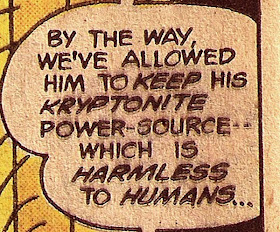In Superman #331, we visit a jail that has been specially designed to house super-villains (the Atomic Skull, the Parasite, and Metallo, possibly with Terra-Man on his way). Each of them dwells in a small box (with a cot and a few vaguely delineated furniture-like objects). Each cell is specially engineered to prevent the escape of that specific villain. (Also, the boxes are draining the villains' powers into special devices that another super-villain will use, but that's neither here nor there.)
Here's Metallo, chillin' in his crib, as it were. Aren't cyborgs cute in slacks?

And why does he still have a chunk of Kryptonite powering his robot body?

... Well, since Kryptonite is harmless to humans, I'm sure that it won't pose any sort of problem in the future.

Oh, and also KRYPTONITE IS CHEAPER THAN RADIUM.
(Radium, by the way, currently costs something like $25,000 per gram. That's expensive, sure, but it seems to imply that you could incapacitate Superman for about the same price as a year's tuition at some snooty colleges.)
The radioactive fragments of an exploded planet light-years away from us cost less than $25,000 per gram.
This is the sort of thing you would only write if (a.) you didn't think your audience was paying very close attention, and (b.) you didn't care what kind of mess you were leaving for other writers who might arrive after you. Thank you, Martin Pasko.
Actually, I suppose it's also possible that Kryptonite is just more efficient, as a power source, than radium — or that Kryptonite lasts longer and therefore needs to be replaced less frequently. But that's not quite what our jail warden seems to be saying.
I don't have much else to say about this. But let's just mark it as another entry in the "comics are dumb" file.









